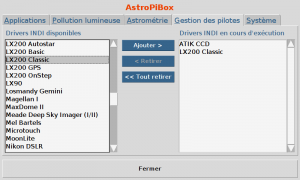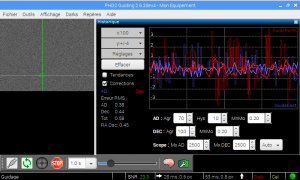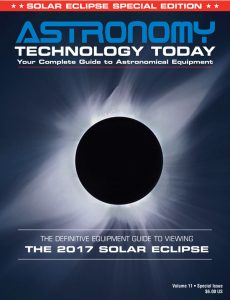 Clear Sky Lab’s AstroPiBox, a French-language autonomous autoguiding platform, is based upon the Raspberry Pi Linux platform. Recently released out of beta, the platform leverages the Raspberry Pi for autoguiding, offering several distinct advantages: (1) Power consumption of only a few watts, which makes it possible to use a portable power supply (5-volt) for hours of continuous field operation; (2) the Linux operating system provides a stable and reliable platform, allowing access to the entire open-source Raspberry Pi ecosystem; and (3) Raspberry Pi is an inexpensive hardware platform that yields quality products at a reasonable price.
Clear Sky Lab’s AstroPiBox, a French-language autonomous autoguiding platform, is based upon the Raspberry Pi Linux platform. Recently released out of beta, the platform leverages the Raspberry Pi for autoguiding, offering several distinct advantages: (1) Power consumption of only a few watts, which makes it possible to use a portable power supply (5-volt) for hours of continuous field operation; (2) the Linux operating system provides a stable and reliable platform, allowing access to the entire open-source Raspberry Pi ecosystem; and (3) Raspberry Pi is an inexpensive hardware platform that yields quality products at a reasonable price.
The interface of AstroPiBox has been designed with a focus on maximum simplicity – it’s easy to launch the various applications installed on the platform, as well as to access its built-in functions.
AstroPiBox is a portable platform for astrophotography whose primary objective is to provide a reliable, easy-to-use, high-quality autoguiding service, but it also includes software and utilities to facilitate both field- and observatory-based astronomy, including cartography software and telescope control, image acquisition, astrometric resolution and simulation of light pollution.
Autonomous Autoguiding
 AstroPiBox integrates PHD2, an open-source software for autoguiding. PHD2 was modified by Clear Sky Lab to run optimally on the Raspberry Pi platform and on a 7-inch touchscreen. All necessary libraries were preinstalled in the AstroPiBox Linux environment to enable direct and simple use of PHD2, and the French translation has been completed and improved.
AstroPiBox integrates PHD2, an open-source software for autoguiding. PHD2 was modified by Clear Sky Lab to run optimally on the Raspberry Pi platform and on a 7-inch touchscreen. All necessary libraries were preinstalled in the AstroPiBox Linux environment to enable direct and simple use of PHD2, and the French translation has been completed and improved.
Tested with several different frames and cameras, it can be used directly in most configurations in plug-n-play mode without the user having to adjust any parameters whatsoever. This makes it extremely easy to use, while still benefiting from the powerful features and algorithms offered by this software. It is, of course, always possible to adjust the numerous parameters of PHD2 if one wishes to refine the results of autoguiding.
AstroPiBox has been tested with the following mounts (either in direct connection or with an ST4 port): HEQ5, NEQ-6, CA-EQ6, EQ8, Vixen GP-DX Sky-Sensor, Astrophysics, Avalon M-Zero, EQ-3-2 / EQ5 GoTo EQ-3-2 / EQ5 motors (with harbor ST4), and EM200. It has also been tested with ZWO, ASI and ATIK cameras.
AstroPiBox integrates a complete INDI manager (the equivalent of ASCOM under Linux) dedicated to astronomy (cameras, telescope controllers, focusing systems, weather stations, etc). The selection of the camera to use with PHD2 is done with a simple click of mouse in the INDI manager integrated in AstroPiBox.
 Planetarium, Go-To and Acquisition of Images
Planetarium, Go-To and Acquisition of Images
AstroPiBox integrates open-source software CCDciel and KStars. The intuitive interface of AstroPiBox makes it easy to launch these programs. In addition to its stellar mapping functions, KStars can control a go-to telescope through the INDI server installed on the Raspberry Pi. CCDciel is a simple and efficient tool for acquiring images from a camera connected to the Raspberry Pi.
Astrometric Resolution
AstroPiBox also integrates an astrometric resolution engine that is specifically focused on the Raspberry Pi platform (no Internet connection required). Simply specify the image you are trying to solve in the interface, as well as the approximate sampling of the sensor, to get the astrometric resolution in a few seconds.
Simulation of Light Pollution
AstroPiBox integrates an original tool to simulate the light pollution produced by public lighting, making it easy to search for the most suitable sites for astronomical observation. Simply specify a point and surrounding area of interest, and AstroPiBox will produce a map of light pollution within a few seconds.
Other Functions
AstroPiBox TouchScreen, the version of AstroPiBox that incorporates a 7-inch screen, provides five dedicated buttons for easily adjusting the screen brightness. In addition, a night-vision mode is available to switch the AstroPiBox software display to red.
Model Versions
Clear Sky Lab offers the system in four versions: (1) AstroPiBox SD, a micro-SD card containing AstroPiBox that is ready to insert into the user’s Raspberry Pi 3 for integration into a user environment; (2) AstroPiBox Basic, a Raspberry Pi with a metal housing and power supply, ready to connect to a screen in HDMI or on a network in VNC mode for integration into a fixed observatory, (3) AstroPiBox TouchScreen, consisting of the Basic package, plus a 7-inch touch screen, for an ultra-portable platform for autoguiding and field-mount control; and (4)
AstroPiBox Laptop, a PiTop with a built-in battery, keyboard, touchpad and 13.3-inch screen, for a self-contained portable platform for autoguiding and field-mount control, as well as for fixed-point control.
Availability
If you are interested in this product, please contact Clear Sky Lab via Contact@cosmodiff.com. For more information, please visit http://astropibox.com/ .
###

The Astronomy Technology Today editorial staff would like to take this opportunity to remind you of the availability of our Solar eclipse equipment guide – The Definitive Equipment Guide to the 2017 Solar Eclipse. Our goal with the 40 page publication is to provide an easy-to-consume introduction to the technological options for viewing and imaging the Great Solar Eclipse. We cover the gamut of options available including building you own solar viewer, solar glasses, smart phones, DSLR cameras, using astronomy telescopes, solar telescopes, using binoculars, solar filters (including a DYI filter option), CCD astro cameras, astro video cameras, webcams and much more. You can view the guide on our website here – its free and there is no requirement to sign up to read the guide.

